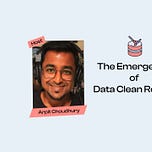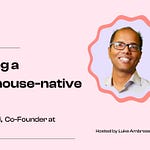If you haven't heard of Data Clean Rooms (DCR), well, you have now!
In this episode, Roopak Gupta walks us through this new technology, the factors leading to it its rise, its impact on privacy compliance and data governance, as well as the top use cases.
Roopak also offers some tips for those evaluating a clean room solution.
Don't miss the conversation, especially if you like to stay on top of the innovations in data privacy tech.
Key takeaways from this conversation:
Q. What is a data clean room?
Roopak (00:36)
Data clean room technology enables partners to collaborate in a secure manner — where their (first-party) data never leaves the source — and generate insights and outcomes that were not possible earlier (without moving the data out of their environment).
Think of it as a distributed data platform that allows the connection and analysis of data across multiple platforms and partners.
My take:
I’ve read about clean rooms being referred to as Switzerland of data and I think it makes it easy to understand the core promise of this new technology.
You bring your data, I bring mine, the neutral party performs joins behind closed doors (that has been swept clean to prevent any leaks), and delivers data points about our common audience. We both receive additional insights from each other’s data while being fully compliant to privacy regulation — now that’s a win-win!
Q. How does a clean room solution help adhere to privacy regulations such as the GDPR?
Roopak (02:44):
A clean room supports both consumer privacy and data governance via the following:
Provides technical guarantees that data is only used for approved purposes, which is huge for compliance
Ensures that data never leaves the data source
Provides complete control of the analysis that can be run with built-in approval flows
Follows the principles of data minimization
Supports data encryption and differential privacy via k-anonymity and noise injection, ensuring that no individual-level data is ever leaked
Q. Can you describe the top use cases for clean rooms?
Roopak (07:28):
Besides analysis and activation, the enrichment of data and the data models is a big one.
Companies don't want to limit themselves to query-based analysis of structured data — they expect clean rooms to support machine learning workloads and protect inputs that are beyond data. We protect proprietary code, and we have customers who enrich their data and their models by enabling secure access to new inputs — something they never had access to earlier.
Q. What should companies look for when evaluating data clean room solutions?
Roopak (08:16):
I would say there are three key things you need to look for in a clean room partner:
Interoperability and automation: It should be tech stack-agnostic and support end-to-end automation.
Flexibility: You should be able to create and customize use cases based on your specific business needs.
Built for privacy, governance, and data decentralization from the ground up: Beware of all the rebranding of legacy offerings that claim to be clean rooms but they're not as they take the same old approach of ingesting your data.
You might also want to subscribe to data beats on Apple, Spotify, YouTube, or wherever you get your podcasts.













Share this post